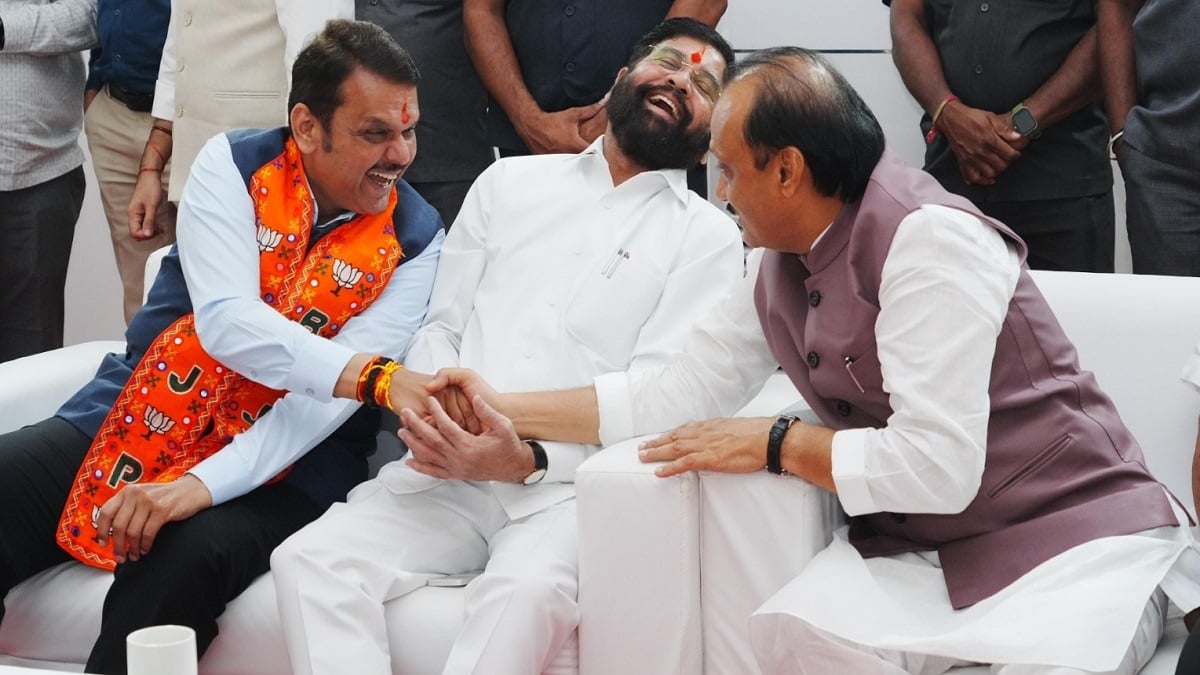Eknath Shinde, Devendra Fadnavis and Ajit Pawar could not have wished for a better result in the Maharashtra assembly elections 2024 | File image
Mumbai: Maharashtra’s elections results have left political pundits scratching their heads and opposition leaders clutching their pearls. For the BJP-led Mahayuti it was a symphony of votes, perfectly orchestrated. For the Congress and the Shiv Sena factions, it was a dirge played on a broken sitar.
As WhatsApp groups buzz with theories and party offices fumble for answers, one question looms large: how did the BJP turn Maharashtra into its latest trophy state? Was it cash, caste, or campaigns? Perhaps a bit of all three, garnished with RSS seasoning and a dollop of opposition ineptitude.
Uddhav Thackeray, visibly disoriented after his coalition’s dismal performance, spoke aloud, “What magic wand did they wave?” Sanjay Raut, his perpetual sidekick, added, “Kuch toh gadbad MAHAYUTI 236 MAHARASHTRA ASSEMELY RESULT 2024 Total Seats 288/288 hat,” reinforcing the notion that if politics doesn’t work out, he has a future in melodrama.
The Mahayuti didn’t just win Maharashtra; it bulldozed its way to 4 near-majority in the 288-seat assembly, leaving its rivals gasping for relevance, The star of the show? Welfare schemes gift wrapped in MVA populist jargen. The Mukhyamantri Majhi Ladki Bahin Yojana promised Rs 1500 per month to women from economically weaker sections thus reaching out to 2.5 crore voters who suddenly found themselves on Mahayuti’s speed dial.
Critics dismissed it as bribe masquerading as a policy initiative, but voters seemed to think, “Better Rs 1,500 today than empty promises tomorrow,” Even as opposition leaders scoffed, the Mahayuti doubled down, pledging to bump the payout to Rs 2,100 after the elections. Call it “cash-for-votes” or “revdi culture,” but the Mahayuti knew its audience: homemakers and daily wagers. who preferred cash in hand to lofty debates on inflation and unemployment. But cash wasn’t the only ace up the Mahayuti’s sleeve.
The real coup was uniting Hindu voters across caste lines. Maharashtra, with its infamous caste fault lines, had long been a chessboard of fragmented loyalties. This time, the BJP deploved its trusted gurn, the RSS, to pull off a masterstroke. Slogans like “Ek hai toh safe hai” (United, we are safe) echoed through villages and towns, while grassroots campaigns knitted together a cohesive Hindu identity.
Meanwhile, the opposition’s house resembled a sitcom, The Congress, despite its Lok Sabha gains earlier this year, seemed lost at sea, with leaders fighting over life jackets. The Maha Vikas Aghadi (MVA)—the uneasy Congress-NCP-Shiv Sena alliance—offered little more than recycled outrage and vague promises. Uddhav Thackeray’s attempts to paint himself a5 a secular statesman alienated his core Hindutva supporters, leaving him stranded in a no-man’s land.
Sharad Pawar’s NCP was still licking its wounds after a faction defected to Ajit Pawar, reducing the party to a shadow of its former self, And then there was the R55—quiet. meticulous, and relentless. It turned this election inte a micro-campaigning masterclass. Forget rallies and hashtags; the Sangh focused on Mohalla Sabhas (neighborhood meetings) and temple gatherings, ensuring that even the remotest villages felt the Mahayutis presence. Programs like “Sajag Raho” (Stay Alert) helped counter anti-Mahayuti narratives while galv.zing voters at the grassroots.
The Mahayuti played the caste card with precision, flipping the script on Maratha politics. While the Maratha agitation for quotas threatened to dominate headlines, the Mahayuti skillfully framed it as a potential threat to OBC interests. This narrative struck a chord with non-Maratha voters, creating a new caste coalition that outflanked the opposition. Add to this Devendra Fadnaviss carefully crafted image as Mr. Stability. Memories of the MVA’s chaotic stint in power were still fresh, and Fadnavis positioned himself as the antidote to drama. His campaign, anchored by the Modi mantra “Modi hai toh mumkin hai” (With Modi, it is possible), promised governance over gimmicks.
Infrastructure development, law-and-order assurances, and economic growth became the Mahayuti’s pitch to voters seeking respite from Maharashtra’ political soap opera. But while the Mahayuti’s victory lap might be well-deserved, challenges are waiting in the wings. Balancing the demands of its allies in the Mahayuti coalition will be no small task, especially with Ajit Pawar and Eknath Shinde’s factions watching the spoils of victory like hawks.
Fulfilling promises like doubling the Ladki Bahin payouts while addressing agrarian distress will test the party’s ability to govern beyond the ballot box. For the opposition, the wakeup call couldnt be louder. The Congress needs to rebuild its local machinery and stop treating state elections as filler episodes between Lok Sabha seasons.
The Shiv Sena must decide if its a Hindutva party, a secular coalition partner, or just perpetually confused. Ultimately, this election wasn’ just about schemes or slogans. It was about the Mahayutis ability to adapt, improvise, and consolidate. Whether by weaponizing welfare, leveraging the RSS, or exploiting caste dynamics, the party played the game with ruthless efficiency. For now, Maharashtra is firmly in Mahayuti’s grasp. But as history reminds us, political fortunes in this state can turn faster than a Bollywood potboiler. Stay tuned; the interval is over, but the drama is far from done.

